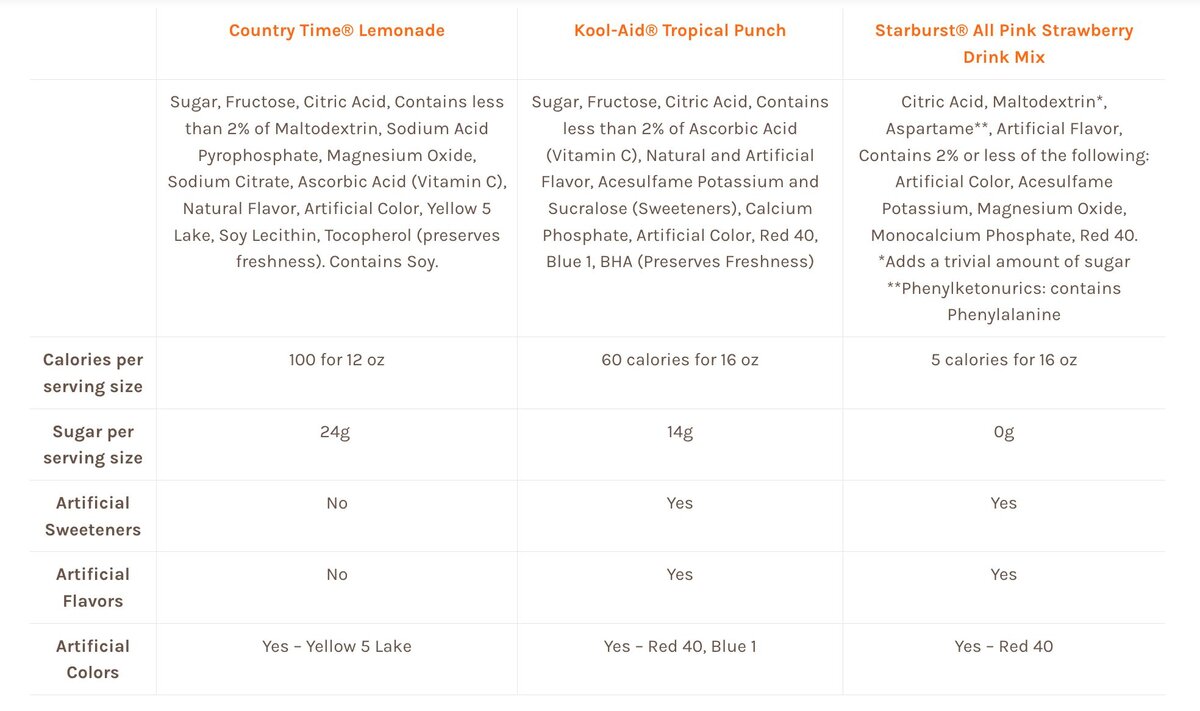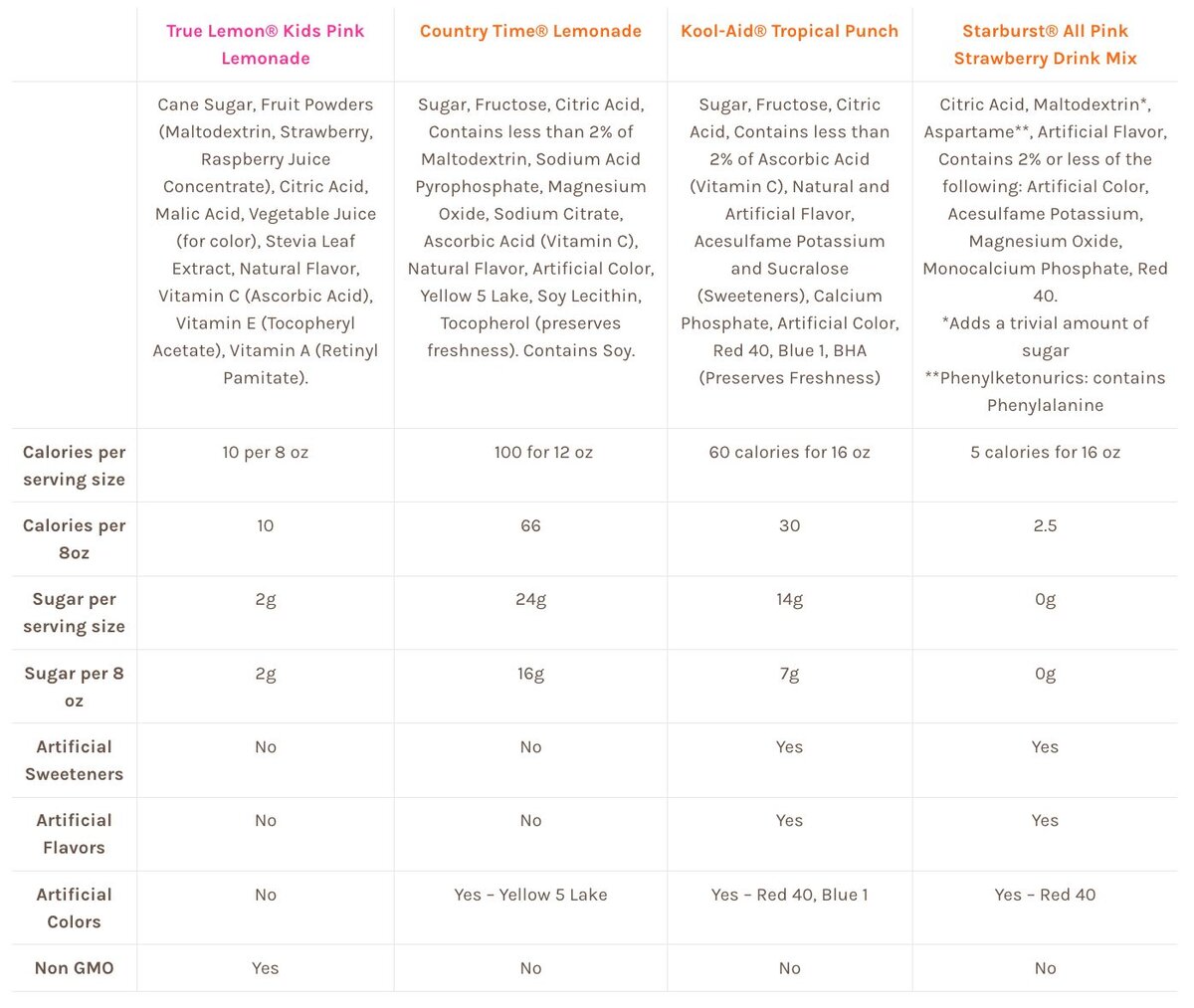
Must It Be a Choice Between This (Good Ingredients) or That (Great Taste)? Why Not Both?
One of the most popular lemonade drink mixes in the country has the following ingredient line:
Sugar, Fructose, Citric Acid, Contains less than 2% of Maltodextrin, Sodium Acid Pyrophosphate, Magnesium Oxide, Sodium Citrate, Ascorbic Acid (Vitamin C), Natural Flavor, Artificial Color, Yellow 5 Lake, Soy Lecithin, Tocopherol (preserves freshness). Contains Soy.
And while this powdered lemonade drink mix has a taste a lot of children and families have come to know, that’s an ingredient line that may make some parents go, “hmmm”. Parents should not have to choose between this (ingredients we feel good about) and that (taste our families feel good about).
Powdered soft drinks (or powdered drink mixes) have a lot of advantages to them. They’re convenient. Most kids can add a powdered drink mix stick packet to their water by themselves. They help kids drink water. They’re shelf stable and don’t spoil or go bad. They’re a good value when compared to more expensive ready-to-drink options. They come in appealing flavors and colors for kids and adults alike. And they produce less waste than a traditional beverage plastic bottle or aluminum can.
And yet. The “yet” is that many powdered soft drink mixes have ingredient lines that parents may not love for our kids. (Again, that this or that problem.)

What's the deal with artificial sweeteners?
Artificial sweeteners were invented so people can still consume the sweetness that as a society we love but without the calorie load or concerns associated with sugar. Many view switching sugar-sweetened products with artificially sweetened products as a healthier choice.
Recent American Academy of Pediatrics’ research has shown that 17% of calories in an American child’s diet comes from sugar, and half of that comes from drinks with added sugar. Clearly, swapping out artificial sweeteners for sugar is a simple way to reduce a child’s daily sugar consumption. Childhood obesity is a real concern and can have lasting health implications as children grow into adults. And while there have been fears that artificial sweeteners cause birth defects, are linked to cancer or are linked to behavior problems, according to the Academy of Nutrition and Dietetics, to date there has been no sound scientific evidence that shows any of those fears to be real.
Artificial sweeteners do have some unknowns and some concerns around their consumption have already emerged. Some studies have shown that certain artificial sweeteners can alter important bacteria in our guts. Some other studies have linked artificial sweetener consumption and Type 2 diabetes, and still others have suggested a possible link between artificial sweeteners and changes in appetite and taste preferences in children (meaning children’s taste changes to prefer sweetness) which can impact weight and health. Additionally, some research has shown that the more artificial sweeteners consumed, the more weight is gained over time.
Concerns about artificial colors
Artificial food dyes – like Red 3, Red 40, Blue 1, Yellow 5, and Yellow 6 – were made to enhance the appearance of food and are made from petroleum. There are two types of FDA approved color additives – dyes and lakes. Dyes are water-soluble and often come in the form of powders, granules or liquids. Lakes are not water-soluble and are often found in products containing fats and oils.
It is important to note that, like artificial sweeteners, the FDA has approved most artificial food dyes and considers them to be completely safe to eat. However, the FDA did note that a population of children may see adverse side effects from artificial dyes which include a small but significant association between artificial food dyes and hyperactivity in some children who may have a higher sensitivity to artificial food dyes than others. Some studies have also linked behavioral changes and hives and asthma in children to artificial food dyes.
And then there's food coloring made from bugs
Not all food that is colored red uses artificial red dye. Some red food dye – labelled as carmine, cochineal extract or natural red 4 in an ingredient line – is made from female cochineal insects, which are often found on prickly pear cacti. To make red dye, manufacturers dry the cochineals and grind them into a powder. (About 70,000 cochineal insects are needed to make a pound of dye.) The powder turns a bright red when mixed with water. While it sounds gross, there are no known health risks to this food dye.
Do we have to give up everything?
At True Citrus, few of us are purists, most of us generally believe in moderation for ourselves and our children. While we believe that there is room to indulge, on a daily basis you shouldn’t have to choose between products you feel good about, and are good for you, and products that taste good. (That is unless you live in a food desert, which is a whole different blog.)
For many American adults and children, simply reducing our sugar intake would be a pretty major accomplishment. And increasing our water intake while decreasing sweetened drinks is also another healthy move. (Though, generally speaking, at True Citrus, since we have the advantage of a steady stream of True Citrus products, we all tend to be very good water drinkers.) For adults, these are good habits to either develop or maintain. For children, they can be part of the mix of habits that provide a foundation of healthy living for their entire lives.
This simple idea – that we all should have products that we feel good about eating/drinking and that taste good - is what led us to create our new line of True Lemon Kids drink mixes. Through research with parents and then a national Taste Test with over 800 families, we’ve created a drink mix for kids that doesn’t make you choose between this (ingredients you can feel good about) or that (great taste kids love).
True Lemon Kids: Parent approved ingredients, kid approved taste
True Lemon Kids is now available at Walmart for $1.97 for a 10-stick packet carton (and available on TrueCitrus.com and in other major grocery stores), True Lemon Kids comes in three delicious flavors, Pink Lemonade, Fruit Punch and Blue Raspberry.
Each stick packet makes an 8-oz serving and has:
- NO artificial sweeteners, flavors or preservatives
- Colors from natural sources like fruits and vegetables
- 25% of a child’s daily Vitamins A, C & E
- Sweetness from Stevia and 2g cane sugar
- 10 calories
- Non-GMO ingredients
- Gluten free
True Lemon Kids drink mixes are a perfect way to switch out highly sweetened beverages (8 ounces of soda or juice has about 24g of sugar!) or artificially sweetened beverages or add another glass of water into your child’s day. As we said, we think this world is big enough for all sorts of beverage choices but we’re very proud to provide a powdered drink mix option that offers Non GMO ingredients, natural flavors and colors made from natural sources. Check out the Ingredient Comparison Chart below to see how True Lemon Kids compares with other popular kids drinks like Country Time, Kool-Aid and Starburst. Hopefully you agree that True Lemon Kids can be part of your child’s healthy diet.

